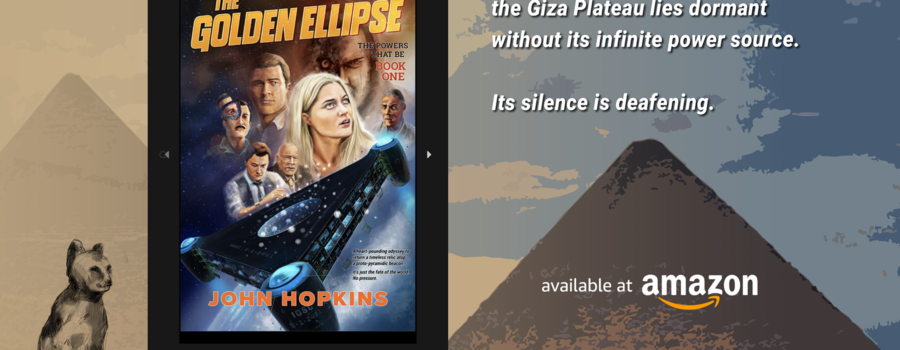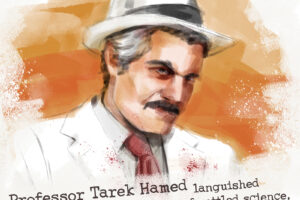In our eternal quest for knowledge, we scrutinize a world replete with ancient enigmas constructed by people and cultures that have receded into a nebulous void lost to time. Despite the best efforts to document ancient civilizations through a modern-day lens, the collective knowledge on a mysterious structure like the Great Pyramid is a murky hypothetical hodgepodge. Nevertheless, any Egyptologist worth their salt can recite the prevailing theories on the Great Pyramid with a high level of certainty.
Taking the pyramid story in a new direction, The Prologue to The Golden Ellipse, Book One in The Powers That Be Trilogy, establishes an intriguing and inventive backstory culminating with the Great Pyramid’s’ purposeful construction. Leveraging scant historical evidence on the pharaoh who built the Seventh Wonder of the World, the book’s alternate history reveals the who, why, and how the iconic structure manifested on a barren Egyptian plateau. Moreover, the “don’t feed the animals” message pulsing from a 90,000-year-old alien beacon concealed deep beneath the pyramid’s massive footprint posits an answer to Fermi’s Paradoxical question [1] while giving form to the novel’s core theme: humankind’s place in the universe.
Another theme permeating throughout the 510-page science fiction novel is acceptance of the unknowable. I understand this can be a hard pill to swallow as we persist in chipping away at cosmic enigmas from past worlds shrouded in mystery. Unquenchable fascination, fantastical speculation, and mind-blowing hypotheses abound regarding vestigial remnants of erstwhile cultures scattered across every continent and far beneath the rivers and seas. And yet, a perfect razor-thin slice in a 10-ton granite boulder or a geoglyphic form stretching for miles mocks our resolute need to know. Perhaps we are humankind 2.0. Or 10.0. Are human beings wired to forget? An iconic movie quote comes to mind: “You can’t handle the truth.” [2]
Approaching this well-known yet dismissive trope from the viewpoint of a fiction author, I intentionally wander far from the consensus playbook. Painting nuanced shades into The Powers That Be mythology through reimagined characters and events weaving in and out of an overarching narrative, I strive for accuracy when describing tangible things like the robbers entrance to the Great Pyramid, yet revel in taking creative liberties on esoterica like anti-gravity. As far as I know, it doesn’t exist. So it is what I say it is. As an aside, I admire the Expanse novels and the authors’ dedication to creating their Epstein Drive as a plausible means of traversing the vastness of space. [3]
Tempest in a teapot…
To quote Shakespeare, “What’s past is prologue.” [4] If that’s true, then the future is also what we make of it. Sounds good. However, it is a common conceit to believe today’s world could never end up as tomorrow’s mystifying archeological find. I take the opposing view that our troubled civilization most assuredly could and probably will end up as some future archeologist’s feverish discovery. I can picture the bloke on hand and knee brushing sandy grit off the exposed tip of a skyscraper jutting from the hardpan of a future world. Man, that sounds cool. As with a lot of things, pop culture weighs heavily on my opinion.
Here are a few dramatic examples:
- The talking doll scene near the end of Planet of the Apes is as iconic as the Statue of Liberty surprise ending. (I do hope I didn’t spoil that for anyone.) [5]
- Another excellent example is the ethereal alien sequence at the end of A.I. Artificial Intelligence. The Spielberg movie is an underrated gem, in my humble estimation. [6]
- Okay, here is another example from my all-time favorite, Raiders of the Lost Ark. It’s the scene with Indy and Belloq in a Cairo bar. Belloq holds out a cheap pocket watch and states the following: “Look at this. It’s worthless – ten dollars from a vendor in the street. But I take it, I bury it in the sand for a thousand years, it becomes priceless. Like the Ark.” [7]
Many enigmatic sites exist on every continent, from the famous Stonehenge to the less-known yet equally puzzling Göbekli Tepe. Many more remain undiscovered beneath dense forests and silty beds of oceans, seas, and rivers—what a treasure trove of stories. While The Golden Ellipse focuses heavily on the Seventh Wonder of the World, the following books in the trilogy will feature more captivating mysteries from our unknowable past. As I have said before and will repeat again and again, skeptics are never satisfied with the status quo. Push past settled science. Question everything and never shy away from controversy. However, be kind and gracious. No one likes a know-it-all.
This post is the second in a series exploring the historical people, places, and events underlying the mythology of The Golden Ellipse and its sweeping narrative spanning eons in time well into our future.
References
- https://www.planetary.org/articles/fermi-paradox-drake-equation
- https://www.imdb.com/title/tt0104257/?ref_=fn_al_tt_1 few
- https://en.wikipedia.org/wiki/The_Expanse_(novel_series)
- https://en.wikipedia.org/wiki/What’s_past_is_prologue
- https://www.imdb.com/title/tt0063442/?ref_=nv_sr_srsg_6 Apes
- https://www.imdb.com/title/tt0212720/ (AI)
- https://www.imdb.com/title/tt0082971/characters/nm0293550








